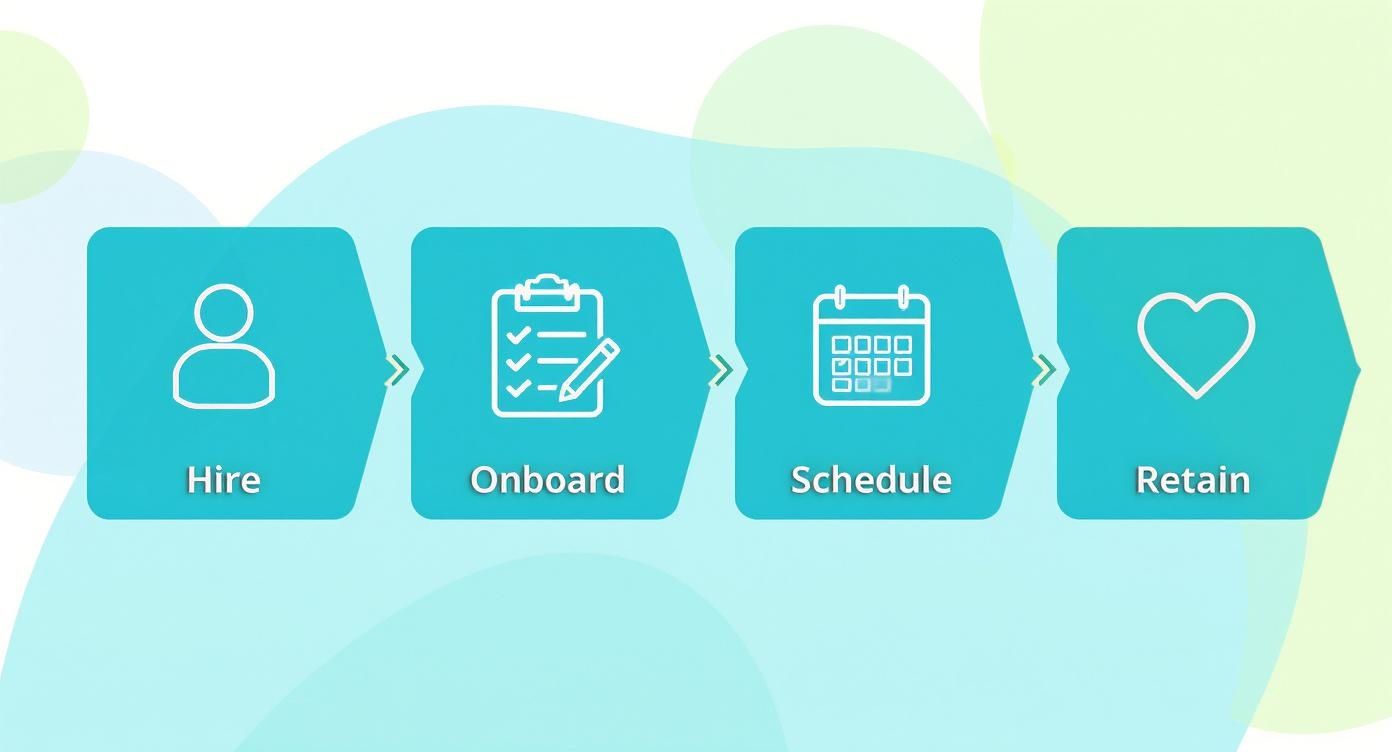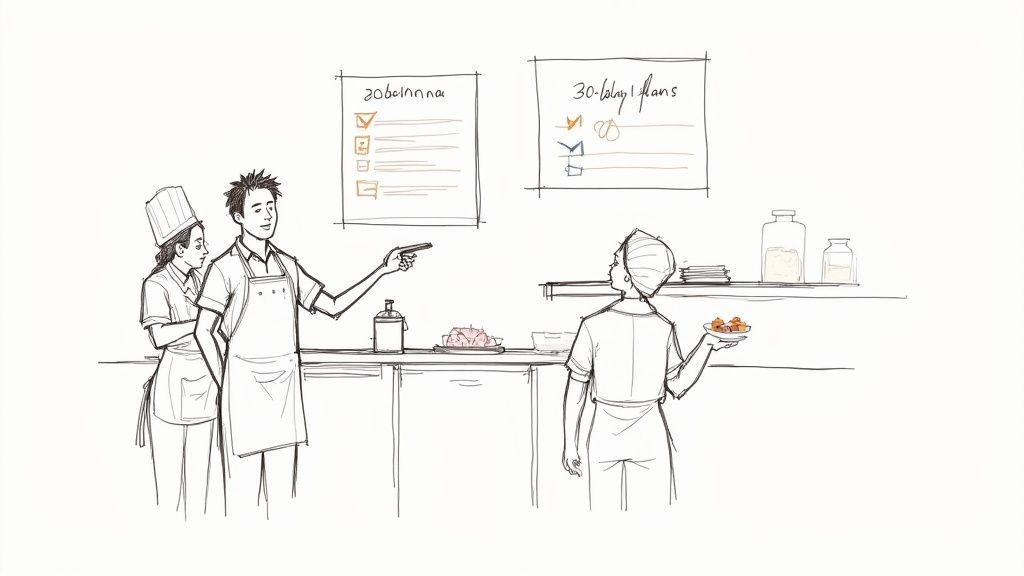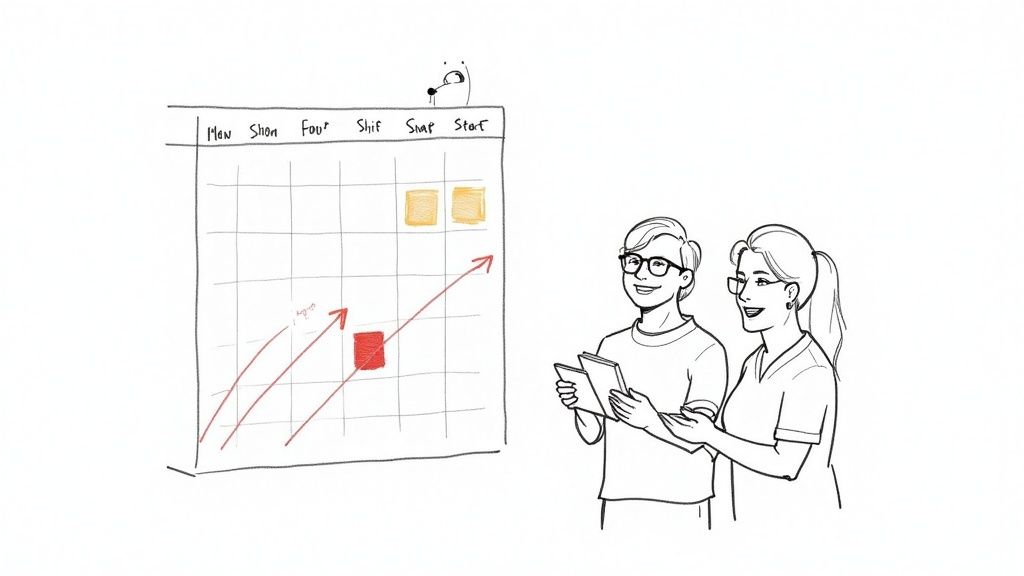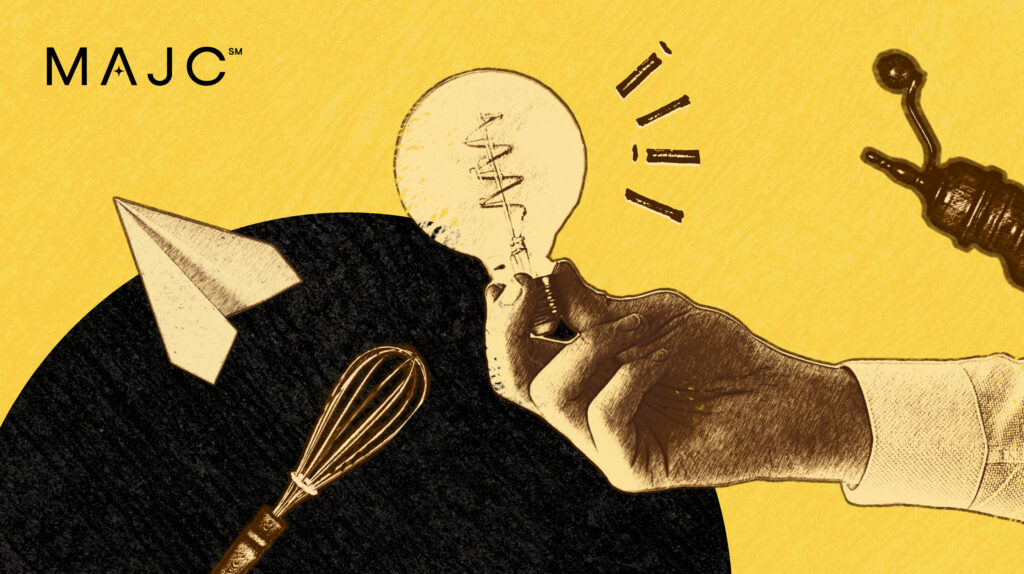Forget the old-school approach of just filling shifts. Truly effective restaurant staff management is about playing the long game, building a motivated, loyal team from the ground up.
It comes down to creating a culture people want to be a part of, offering fair and predictable scheduling, and providing consistent training that shows you’re invested in their growth. This is how you turn a high-turnover job into a rewarding career path.
Your Blueprint for Modern Staff Management
In today’s hospitality market, learning how to manage your team is your single greatest advantage. The industry is still grappling with labor shortages and sky-high employee expectations, making a thoughtful management strategy more critical than ever.
It’s no longer enough to just hire bodies to fill a schedule. You need to build a cohesive unit that feels valued, supported, and wants to stick around. That means looking at the entire employee lifecycle as one connected system.
This is a simple way to visualize the core pillars of modern staff management.

This flow, from hiring to retaining, shows that management is a continuous cycle, not a one-and-done task. Each stage directly impacts the next. Great hiring makes onboarding easier, strong onboarding leads to better performance, and consistent performance is the key to retention. It all feeds into itself.
Why This Matters More than Ever
The stakes have never been higher. For most restaurants, labor costs are one of the largest expenses, typically accounting for 25–35% of total revenue, depending on the restaurant type and service model, according to Lightspeed. At the same time, nearly 45% of operators admit they don’t have enough staff to meet customer demand, a challenge highlighted by the National Restaurant Association that directly impacts both service quality and profitability.
Smart managers are fighting back by focusing on what their teams actually value. Flexible scheduling, identified as a top priority for 56% of restaurant employees in a 7shifts report, can make all the difference.
The heart of modern management is recognizing that your staff is your most valuable asset. Investing in their development, well-being, and work-life balance isn’t a “nice-to-have”; it’s a direct investment in your restaurant’s success and longevity.
To help you keep these strategies straight, here’s a quick breakdown of the core pillars we’ll be covering.
Core Pillars of Modern Staff Management
| Pillar | Key Focus Area | Primary Goal |
|---|---|---|
| Recruiting & Hiring | Attracting and selecting the right talent. | Build a strong pipeline of candidates who fit your culture. |
| Onboarding & Training | Setting new hires up for success. | Reduce ramp-up time and integrate staff effectively. |
| Performance & Growth | Managing performance and fostering development. | Motivate staff and create clear paths for advancement. |
| Culture & Retention | Creating a positive and supportive workplace. | Increase loyalty and reduce costly employee turnover. |
Each of these pillars is essential for building a resilient and profitable operation. When you focus on creating a supportive environment, you don’t just improve morale; you build a reputation as an employer of choice. This idea is central to our operator guide for improving talent retention, which helps restaurants build stronger, longer-lasting teams.
How to Hire People Who Actually Fit Your Culture
Hiring the right person is so much more than plugging a hole in the schedule. It’s about finding people who will genuinely thrive in your restaurant’s specific environment. After all, every restaurant has a unique vibe; the right person for a high-energy kitchen could be a disaster in a relaxed, intimate dining room.
A resume tells you what someone has done, but it rarely tells you who they are under pressure. Your goal is to find people who are wired for hospitality, teamwork, and a solid work ethic. That alignment is what separates a crew that just clocks in from a team that has each other’s backs through the chaos of a busy service.
Crafting Job Descriptions That Attract the Right People
Think of your job description as your first filter. A generic post attracts generic applicants, wasting your time. To get passionate, dedicated staff, write a description that speaks their language and shows off your restaurant’s personality. Don’t just list responsibilities, paint a picture of what it’s actually like to work with you.
For example, instead of the tired old line, “Must handle a fast-paced environment,” try something with more flavor:
“You’ll be part of a tight-knit kitchen crew where communication and precision are everything. We thrive on the energy of a packed house and support each other to deliver an exceptional dining experience, every single service.”
That small shift does some heavy lifting. The right candidate will feel a jolt of excitement, while the person looking for a quiet gig will know to keep scrolling. You’re helping them self-select before they even apply.
Moving Beyond Standard Interview Questions
The interview is your chance to see past rehearsed answers. Lean on behavioral and situational questions to get a glimpse into their real problem-solving skills, attitude, and how they react when things go sideways. Good questions get to the heart of what it means to work in this business.
Here are a few questions that dig a little deeper:
- For Front of House: “Tell me about a time you had to deal with a genuinely unhappy guest. What was the situation, and how did you turn it around?”
- For Back of House: “Describe a mistake you made during a busy service. What did you do immediately after, and what did you learn from it?”
- For Any Role: “What does ‘teamwork’ look like to you on a chaotic Friday night?”
Listen carefully. You’re not hunting for perfection. You’re looking for honesty, accountability, and a problem-solving mindset. A candidate who owns up to a mistake and explains what they learned is infinitely more valuable than one who pretends they’ve never made one. This is how you hire for both skill and character.
Mastering Onboarding and Continuous Training
You can hire the best person in the world, but their fire will fizzle out fast if they’re thrown into a confusing, sink-or-swim onboarding process. Great staff management begins with a welcome experience that sets your new people up to win. Handing someone a manual and pointing them toward the floor is a recipe for disaster and quick turnover.
Think of onboarding as a guided journey, not a one-day event. Those first few weeks are your chance to build a new hire’s confidence, clarify expectations, and get them plugged into the rhythm of your team. This is how you turn a promising candidate into a keeper.

Putting in the effort up front pays off big time. You’ll see fewer mistakes, a tighter team, and new hires who know you’re genuinely invested in them from day one.
Build a Structured 30-Day Plan
A solid 30-day plan is the roadmap your new hire needs. It breaks down an overwhelming amount of information into achievable daily and weekly goals, killing that “thrown to the wolves” feeling that drives so many good people out of restaurants.
Here’s a practical plan:
- Week 1: Focus on the Fundamentals. Handle HR paperwork, give a full tour, introduce them to everyone, and do a deep dive into the menu and POS system.
- Week 2: Shadowing and Guided Practice. Pair the new hire with a reliable, positive team member. This is where they see your service standards in action and learn the unwritten rules of your culture.
- Weeks 3 & 4: Ramp Up Independence. Give them more responsibility gradually, like taking a few tables or running a station with senior staff nearby for backup. Do daily check-ins to answer questions and offer constructive feedback.
By the end of the month, your new hire should feel like a real part of the team. For a deeper look into this process, check out our complete guide on how to train restaurant staff quickly and effectively.
Onboarding isn’t just a one-week event; it’s a month-long process of integration. The goal is to build a foundation of competence and confidence that empowers your staff to excel independently.
The industry has settled into a ‘new normal’ post-pandemic, with monthly hiring rates hovering around 5.1% in early 2025. Today’s workforce wants more flexibility and support, a clear signal that old-school tactics won’t cut it anymore. You can find more insights on these hiring and retention trends at Escoffier Global.
From Onboarding to Ongoing Growth
Great training can’t stop after 30 days. To keep your team skilled and engaged, you have to make learning a continuous thing. This shows them there’s a future at your restaurant, turning a job into a potential career. This doesn’t have to be complicated or expensive; simple initiatives can make a massive difference.
Actionable Ideas for Continuous Training:
- Strategic Cross-Training: Teach hosts to manage takeout orders or servers to help on the bar. This builds a more nimble team that can pivot during a rush and cover staffing gaps.
- Peer-to-Peer Mentorship: Have your best bartender teach a new server about wine pairings. This sharpens the server’s skills and recognizes the bartender’s expertise.
- Supplier-Led Training: Ask your wine or coffee supplier to run a tasting session. They get specialized knowledge they can pass on to guests, elevating the entire dining experience.
Every bit of time and money you invest in your team’s skills is a direct investment in your restaurant’s success. It builds loyalty, cuts down on turnover, and creates a crew that delivers outstanding service.
Building Schedules That People Actually Like
Scheduling is where management theory hits real life. It’s more than just filling a spreadsheet; it’s a direct reflection of how much you respect your team’s time and well-being. Get it right, and it boosts morale. Get it wrong, and you’ll burn out your best people.
The goal is to move from a last-minute scramble to a system that’s predictable, fair, and flexible. A solid schedule prevents the nightmare of an understaffed Saturday night and the wasted labor of an overstaffed Tuesday lunch. It’s about building a framework that serves both the business and the people who make it run.

This approach builds a foundation of trust that keeps your team engaged and cuts down on the constant scramble to cover shifts.
Embrace Technology for Smarter Scheduling
Still building schedules on paper or a clunky spreadsheet? Modern scheduling software is a game-changer. These tools can sync with your POS to forecast demand, helping you staff up for rushes and trim hours during lulls. This is critical when you consider the industry’s turnover problem.
Restaurant staff turnover is a huge challenge, with quick-service restaurants often experiencing annual turnover rates exceeding 130%, as reported by Paytronix. This makes retention one of the industry’s toughest obstacles. Smart operators are adopting better tools — and for good reason. More than three in four restaurant operators say technology gives them a competitive edge, helping them make smarter staffing and operational decisions, according to the National Restaurant Association.
These platforms also make life easier for your staff:
- Easy Shift Swapping: Employees can request swaps through an app, which you can approve with a click.
- Clear Availability: Staff can input their availability and time-off requests directly, eliminating misunderstandings.
- Instant Communication: Schedules are published and updated in real-time, with notifications sent to your team’s phones.
Build Fairness and Flexibility Into the System
Even with the best tech, a schedule is only as good as the principles behind it. Fairness means spreading the good, and not-so-good, shifts around. If the same people always get stuck with the dreaded “clopening” shift (closing one night and opening the next), resentment will build fast.
Flexibility is about acknowledging that your staff have lives outside the restaurant. While you can’t say yes to every request, a system that allows for reasonable flexibility shows you respect them as people. This is where having clear guidelines for time-off requests and shift swaps is a lifesaver. When the rules are clear and applied consistently, it cuts out drama and favoritism.
Creating a schedule that works is a balancing act. It must meet the needs of the business, comply with labor laws, and treat employees as valued individuals. Nail this, and you’ll build loyalty that lasts.
By putting these practices in place, you’ll be well on your way to avoiding the most common scheduling mistakes in restaurants and how to fix them.
Fostering a Culture of Communication and Recognition
A positive culture isn’t something that just happens; it’s built one intentional act at a time. It’s your best defense against turnover and the secret ingredient for a team that genuinely wants to come to work. When you nail communication and make recognition a regular practice, you build a place where people feel seen, respected, and proud of what they do.

Run Pre-Shift Meetings That Actually Motivate
The pre-shift huddle is your best chance to set the tone for the day. Too often, it’s just a monotonous rundown of specials. A great pre-shift, however, is a quick, high-energy moment that gets everyone aligned and fired up. Keep it to 10-15 minutes and make every second count.
- Celebrate a Win: Did a server get a great online review? Shout them out.
- Share a Quick Tip: Offer something concrete, like a new way to describe a wine pairing.
- Set a Collective Goal: Frame a simple goal for the shift, like, “Let’s focus on selling ten of the new dessert special.”
This small change turns a routine meeting into a ritual that builds camaraderie and reinforces your standards.
Create Channels for Honest Feedback
Your staff sees things you don’t. They know what’s working on the floor and what isn’t, but they’ll only share those insights if they feel safe doing so. Regular one-on-one check-ins are perfect for this. These low-pressure conversations let you ask direct questions like, “What’s one thing we could do to make your shift easier?”
A culture where employees feel heard is a culture where problems get solved faster. When your team knows their voice matters, they become active partners in the restaurant’s success, not just employees punching a clock.
This open dialogue is a cornerstone of building a high-performing restaurant team culture that lasts and keeps your whole team engaged. A supportive management style isn’t just “nice to have”; it’s a core business strategy for reducing turnover.
Impact of Management Style on Staff Retention
| Metric | Supportive & Flexible Management | Traditional & Rigid Management |
|---|---|---|
| Employee Turnover | Lower rates; staff feel valued and invested | Higher rates; staff feel disposable and burn out quickly |
| Team Morale | High; fosters collaboration and a positive atmosphere | Low; creates a tense, “us vs. them” environment |
| Engagement | High; team members offer ideas and take ownership | Low; staff do the bare minimum to avoid trouble |
| Guest Experience | Better; happy, empowered staff deliver genuine hospitality | Inconsistent; stressed staff can lead to poor service |
The data is clear: flexibility, support, and open communication are critical tools for retention. A rigid approach might feel like it maintains control, but it often drives your best people away.
Recognition That Works for Any Budget
Making your staff feel valued doesn’t have to break the bank. Consistent, low-cost recognition is often more impactful than occasional bonuses because it’s more frequent. The key is to be specific and genuine.
Low-Cost Recognition Ideas:
- A “kudos” channel in your team chat for peer-to-peer shout-outs.
- A hand-written thank you note for someone who picked up an extra shift.
- Offering the “best” section or first choice of shifts to a top performer.
- A small, on-the-spot reward like a gift card for coffee after a perfect service recovery.
These small gestures show you’re paying attention and you appreciate the hard work your team puts in every day.
Navigating Performance and Difficult Conversations
Great management isn’t just about celebrating wins; it’s about holding a high standard for everyone. Knowing how to handle tough but necessary conversations about performance is what separates a manager from a true leader.
The goal here isn’t to criticize; it’s to correct. When you approach performance issues with a genuine desire to help your staff improve, you can turn a tense interaction into a growth opportunity. It all comes down to being clear, fair, and consistent.
Giving Feedback That Actually Helps
Delivering constructive feedback is a skill. Forget the confusing “compliment sandwich.” A much better way is to be direct, specific, and focused on the behavior, not the person. Instead of saying, “You’re too slow,” which sounds like a personal attack, frame it around a specific, observable action.
Try this: “I noticed during last night’s service that it took about ten minutes to clear and reset tables in your section. Our goal is to keep that under five minutes. What can we do together to help you hit that mark?”
This approach is specific, solution-oriented, and collaborative. And remember, always have these conversations in private. Public criticism crushes trust and creates a culture of fear.
The Importance of Documentation
When performance issues don’t resolve after a conversation, documentation becomes your most important tool. This isn’t about building a case against someone; it’s about creating a clear, factual record of what happened, the feedback given, and the agreed-upon steps for improvement. This protects both the business and the employee by ensuring a fair process.
A well-documented performance issue should read like a logbook, not a diary. Record dates, specific examples, the feedback you gave, and the employee’s action plan. This clarity is crucial if disciplinary action becomes necessary.
This process also forces you to be consistent. If you ever have to let someone go, you’ll have a clear record showing you gave them every fair chance to improve.
Handling Disciplinary Actions and Terminations
Nobody enjoys taking disciplinary action or firing someone, but sometimes it’s unavoidable. When you get to this point, handle the conversation with professionalism and respect. Schedule a private meeting, have another manager present if possible, and be direct.
Explain the decision clearly, referencing the documented issues and previous conversations. Don’t get dragged into a debate. This is a moment for clarity, not negotiation. Even in a tough conversation, empathy goes a long way. How you handle someone’s exit says just as much about your culture as how you welcome a new hire.
Your Top Questions, Answered
Every restaurant manager faces the same tough situations. How you handle them is what separates the pros from the rookies. Think of this as a quick-reference guide for those moments when you need a clear answer, right now.
How do I handle conflict between two staff members?
Address it immediately and privately. Don’t let tension simmer on the floor. Pull each person aside, one-on-one, and listen to their side of the story without interruption. Then, bring them together for a mediated conversation. Your job is to facilitate, not to be a judge. Guide the conversation toward professional conduct and figure out how they can work together respectfully.
The goal isn’t friendship; it’s a functional, professional working relationship. Remind them that teamwork is a non-negotiable part of the job and be crystal clear about your expectations moving forward.
What is the best way to keep the team motivated during slow seasons?
The slow season can kill morale if you let it. Instead of just slashing hours, use the time productively. This is your golden opportunity for deep-cleaning projects, organizing the stockroom, and, most importantly, investing in your people’s skills.
- Run workshops on upselling or mastering new menu items.
- Cross-train your best people in different roles. A server who knows the host stand is invaluable during a surprise rush.
- Host a tasting with a supplier. Deeper product knowledge leads to better guest experiences and higher sales.
When you use downtime to build skills, you’re showing your team you’re investing in their growth, turning a slow period into a launchpad for your next busy season.
Should I promote from within or hire externally for a management role?
Honestly, there are good arguments for both. Promoting from within is a massive morale booster. It sends a powerful message that hard work is rewarded and you can build a career there. It gives you a leader who already understands your restaurant’s culture.
On the other hand, an outside manager can bring fresh energy and new skills. An external hire isn’t caught up in existing cliques or “the way we’ve always done it,” so they can often spot opportunities for improvement more clearly.
A good rule of thumb is to always look internally first. If you have a rockstar on your team who’s ready to step up, they already know your systems and your people. But if no one is ready, don’t force it. Go find the expertise you need to take your restaurant to the next level.
At MAJC, we provide the tools, training, and community support that restaurant operators need to build thriving teams and sustainable businesses. From expert-led workshops to a library of practical templates, we’re here to help you hire better, retain longer, and run smarter. Explore how MAJC can support your management journey.
